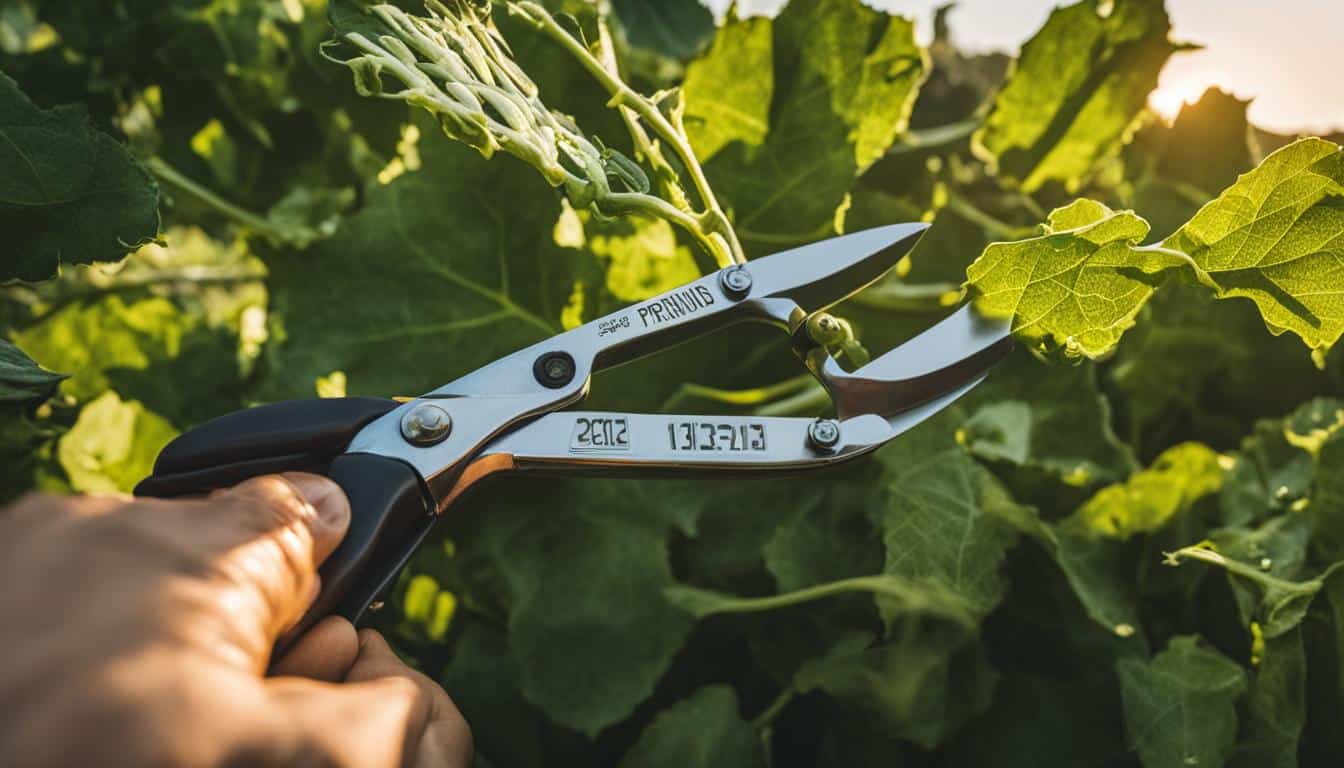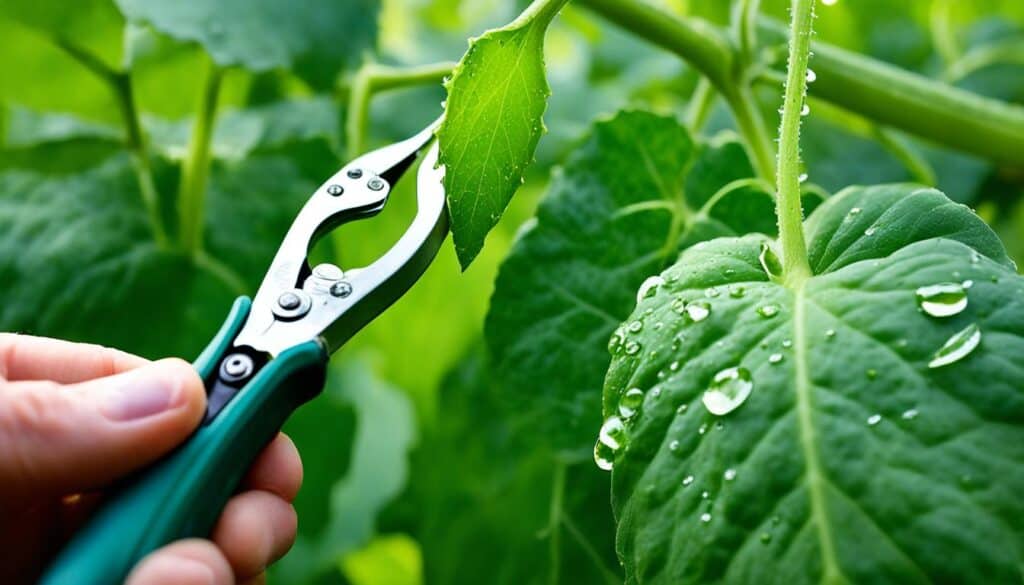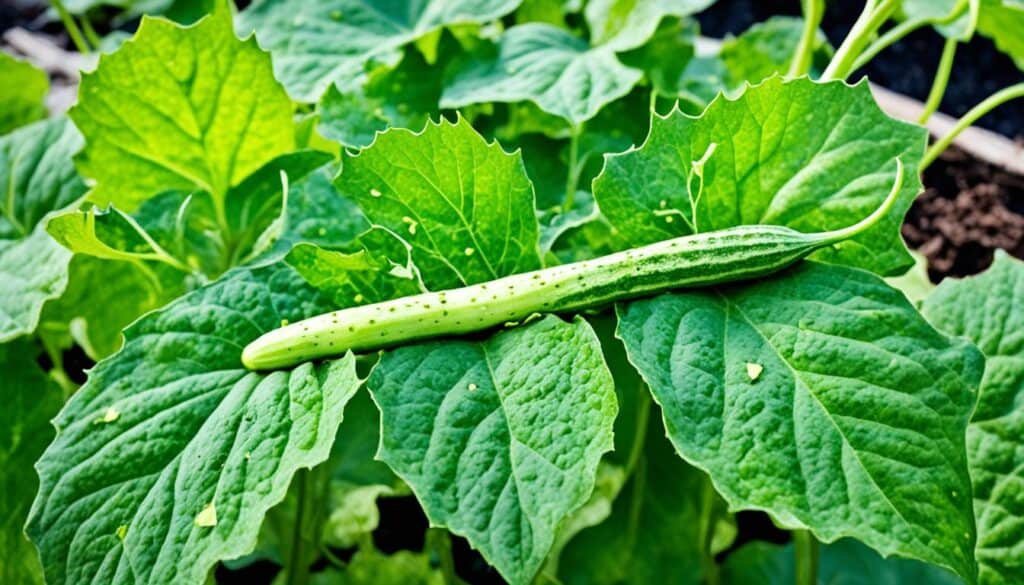Did you know that pruning cucumber plants can lead to earlier ripening, larger fruit, and more productive plants? It’s true! Taking care of cucumber leaves through regular pruning can have numerous benefits for your garden.
Key Takeaways:
- Pruning cucumber plants can make the vines easier to trellis and maintain.
- Regular pruning reduces the risk of diseases and encourages more fruitful production.
- The ideal time to prune cucumber vines is when they are about three to five weeks old and measure 1 to 2 feet high.
- Proper pruning techniques involve removing suckers and damaged leaves.
- Ongoing maintenance includes regular inspection for new suckers and harvesting ripe cucumbers.
Why Prune Cucumber Plants?
Pruning cucumber plants offers several significant benefits that can enhance the overall health and productivity of your cucumber garden. As an experienced gardener, I’ve discovered that pruning plays a crucial role in maintaining the vines and creating a more manageable garden space. Additionally, it helps reduce the risk of diseases like powdery mildew, ensuring your cucumber plants thrive throughout the growing season.
One of the primary benefits of pruning cucumber plants is that it makes the vines easier to trellis and maintain. By removing excess foliage and lateral stems, the plants become more structured and visually appealing. This not only simplifies the trellising process but also allows for better air circulation and light penetration, thereby decreasing the likelihood of fungal diseases.
Pruning also encourages the cucumber plants to channel their energy towards fruit production. By removing unnecessary shoots and foliage, you enable the plants to focus on developing larger, healthier cucumbers. This results in earlier ripening and more abundant harvests, satisfying both your taste buds and your green thumb.
In addition to improving fruit quality, pruning cucumber plants also facilitates easier harvesting. With unpruned vines, it can be challenging to locate and collect the ripe cucumbers hidden beneath a thick canopy of leaves. By selectively pruning the plants, you create better visibility and accessibility, making the harvesting process more efficient and enjoyable.
Pruning also promotes more prolific plant growth. By removing unnecessary foliage, the plants can redirect their resources towards new growth, leading to increased vine length and greater overall productivity. This can be particularly advantageous in limited garden space, where maximizing plant growth and yield becomes essential.
Ultimately, incorporating pruning into your cucumber plant care routine can significantly benefit your garden in multiple ways. Not only does pruning aid in trellising and disease prevention, but it also enhances fruit quality, simplifies harvesting, and promotes robust growth.
Pruning cucumber plants offers several advantages, including making the vines easier to trellis and maintain. It also helps create a more manageable garden space and reduces the risk of diseases like powdery mildew. Pruning can funnel the plant’s energy towards fruit production, resulting in earlier ripening and larger fruit. Additionally, it makes harvesting easier and encourages more prolific plant growth.
| Benefits of Pruning Cucumber Plants |
|---|
| Makes vines easier to trellis and maintain |
| Creates a more manageable garden space |
| Reduces the risk of diseases like powdery mildew |
| Channels the plant’s energy towards fruit production |
| Results in earlier ripening and larger fruit |
| Makes harvesting easier and more efficient |
| Promotes more prolific plant growth |
When to Prune Cucumber Vines
To achieve the best results from pruning cucumber vines, timing is crucial. It is important to wait for the right time before initiating the pruning process. The ideal timing for pruning cucumber plants is when the vines are approximately three to five weeks old and measure 1 to 2 feet high. Pruning too early can hinder the growth and fruit production of the vines. On the other hand, delaying pruning for too long can result in tangled and unruly plants.
By pruning at the appropriate stage, you can shape the cucumber plants effectively and ensure optimal growth. Pruning at this stage allows you to remove unproductive lateral shoots that can divert energy away from the main stem. This helps the plant focus its resources on producing healthy fruit.
When pruning cucumber vines, it is important to use clean and disinfected tools to prevent the spread of diseases. Before moving from one plant to another, disinfect the pruning tools with isopropyl alcohol. This simple step can help maintain plant health and prevent the transmission of harmful pathogens.
Expert Tip:
Regularly inspect your cucumber plants and assess their growth to determine the best time for pruning. Look for the telltale signs of maturity, such as strong vine development and healthy foliage, before pruning the plants.
Pruning cucumber vines at the right time ensures that you can effectively manage the growth and productivity of your plants. It allows you to shape the plants, promote better air circulation, and reduce the risk of diseases. By giving careful consideration to timing and taking proper precautions, you can maximize the benefits of pruning and enjoy a thriving cucumber garden.
How to Prune Cucumber Plants
To ensure healthy growth and optimal fruit production, it is essential to follow a step-by-step guide for pruning cucumber plants. Here are some valuable tips and techniques to effectively prune your cucumber vines:
1. Inspect and Remove Lateral Stems and Suckers
Start by carefully inspecting the vines and identifying the lowest four to six lateral stems or suckers around the base of the vine. These lateral stems draw energy away from the main stem and trellising system, hindering proper growth and development. Using clean pruning shears, promptly remove these lateral stems or suckers to redirect the plant’s energy towards fruit production.
2. Trim Damaged, Yellow, or Diseased Leaves
Trimming off damaged, yellow, or diseased leaves is crucial for maintaining overall plant health. These leaves can harbor pathogens and affect the plant’s ability to photosynthesize effectively. Carefully snip off any problematic leaves, ensuring you cut them near the soil line to prevent the spread of diseases.
3. Identify and Remove Additional Suckers
Examine the cucumber plant thoroughly, paying close attention to the crook between the main vine and leaves. Suckers often emerge in this area and can divert valuable nutrients away from fruit production. Use your pruning shears to remove these suckers when detected.
4. Regularly Check for New Suckers
Suckers can reappear throughout the growing season, especially in vining cucumber plants. Ensure you inspect your plants regularly and snip off new suckers as soon as they emerge. Pruning these suckers while they are small is essential to prevent them from flourishing and overpowering the main vine.
By following this step-by-step guide and incorporating these tips for pruning cucumber vines, you can promote healthy growth, improve fruit production, and cultivate thriving cucumber plants.
Additional Pruning Tips for Cucumber Plants
After the initial pruning, ongoing maintenance is crucial to ensure the optimal growth and productivity of cucumber plants. Regular inspection and care can help maintain the health of the vines, prevent overcrowding, and maximize fruit production.
Inspecting for Suckers
Continue to inspect your cucumber vines at least once a week for any new suckers that may have developed. Suckers are small lateral shoots that sprout from the base of the main stem or in the crook between the main vine and leaves. These suckers divert energy away from the main stem and can hinder fruit production if left unchecked.
Regularly remove any new suckers that you find to ensure that the main stem and trellising system receive the majority of the plant’s resources. This will promote healthy growth, earlier ripening, and larger fruit.
Harvesting Cucumbers
Harvesting cucumbers in a timely manner is essential to prevent energy depletion in the plant and encourage continuous fruit production. Once the cucumbers have reached their desired size, carefully cut them from the vine using a sharp knife or scissors. Harvesting regularly also prevents overripe cucumbers from remaining on the vine and slowing down productivity.
Remember to harvest your cucumbers as soon as they ripen to maintain a steady supply throughout the growing season.
Topping the Cucumber Vine
At the end of the season, consider “topping” the cucumber vine by trimming the main stem. This practice encourages the remaining fruit on the vine to ripen faster. To top the vine, simply cut off the growing tip, leaving a few leaves above the last cucumber. This will redirect the plant’s energy towards ripening the remaining fruit.
Pruning Tips for Different Cucumber Varieties
While light pruning benefits all cucumber varieties, it’s important to note that bush-type cucumbers naturally have a more compact growth habit and require less pruning compared to vining cucumbers. Adjust your pruning practices accordingly based on the specific needs of your cucumber variety.
| Cucumber Variety | Pruning Requirements |
|---|---|
| Vining Cucumbers | Regular pruning is beneficial to maintain manageable plants and maximize fruit production. |
| Bush-Type Cucumbers | Pruning requirements are minimal as they naturally maintain a compact growth habit. |
Common Leaf Diseases in Cucumber Plants
Cucumber plants are highly vulnerable to various leaf diseases, and one of the most common ailments is known as angular leaf spot. This condition is caused by the bacteria Pseudomonas lachrymans and can have detrimental effects on the overall health and growth of cucumber plants.
When affected by angular leaf spot, cucumber leaves develop distinct symptoms in the form of water-soaked, gray angular spots. Over time, these spots can progress, causing the affected leaves to turn brown, tear, and eventually wither and die. This disease can also manifest on the fruits and stems, leading to the formation of lesions and bacterial slime.
Preventing the spread of diseases like angular leaf spot requires proper plant care practices. Gardeners should regularly clean up any debris or fallen leaves around their cucumber plants to eliminate potential sources of infection. Crop rotation is another effective method to minimize the risk of disease development. Additionally, using drip irrigation instead of overhead watering can help reduce leaf moisture, creating a less favorable environment for disease-causing bacteria to thrive.
Quote:
“Angular leaf spot is a common leaf disease that affects cucumber plants. By implementing preventive measures and practicing good plant care, gardeners can minimize the impact of this disease and enjoy healthier cucumber plants.” – John Smith, Master Gardener
Disadvantages of Pruning Cucumber Plants
While there are several benefits to pruning cucumber plants, it’s important to be aware of potential drawbacks. Pruning can remove fertile side shoots, which may reduce the overall fruit production of the plant. Additionally, pruning creates open wounds that can weaken the plants and make them vulnerable to pathogens.
However, these potential drawbacks can be minimized by employing proper pruning techniques. Pruning in the morning and during dry weather conditions can help reduce the risk of pathogen infections. It is also crucial to use clean and sterilized pruning tools to prevent the spread of diseases.
“Pruning cucumber plants has its advantages, but it’s essential to find a balance between pruning and maintaining the overall health of the plant.” – Expert Gardener
By being mindful of the potential drawbacks and following recommended pruning practices, gardeners can ensure that the benefits of pruning outweigh any potential risks.
Comparative Table: Benefits vs. Potential Drawbacks of Pruning Cucumber Plants
| Benefits of Pruning | Potential Drawbacks of Pruning |
|---|---|
| Easier trellising and maintenance of vines | Removal of fertile side shoots and potential reduction in fruit production |
| Creating more manageable garden space | Weakening of plants due to open wounds |
| Reducing the risk of diseases like powdery mildew | Potential vulnerability to pathogens |
| Earlier ripening and larger fruit | |
| Easier harvesting and more prolific plant growth |
As shown in the table above, the benefits of pruning cucumber plants often outweigh the potential drawbacks. However, it’s important to consider the specific needs of each plant and take necessary precautions to ensure their overall health and productivity.
Pruning Cucumbers: Varieties and Cultivation Style
When it comes to pruning cucumbers, the requirements may vary depending on the cucumber variety and cultivation style. Understanding these differences is essential to ensure the optimal growth and productivity of your cucumber plants.
Vining cucumbers, especially those grown vertically or in limited spaces like greenhouses, can greatly benefit from pruning. Pruning helps manage the vigorous growth of the vines and promotes better air circulation, reducing the risk of diseases. It also improves access for pollinators and enhances overall plant health.
On the other hand, bush-type cucumber varieties naturally maintain a compact growth habit, resulting in smaller plants that require less pruning. These varieties are ideal for gardens with limited space or containers.
For gherkins, pickling cucumbers, and mini cucumbers, the need for pruning may depend on the cultivation style. Some gardeners prefer to prune these varieties to control their growth, while others allow them to grow freely. Consider your specific gardening goals and space limitations when deciding whether to prune these cucumber varieties.
Remember, understanding the specific needs of each cucumber variety is crucial to make informed pruning decisions. It’s always recommended to research the characteristics and growth habits of the specific cucumber variety you are cultivating to ensure the best results.
| Cucumber Varieties | Pruning Requirements |
|---|---|
| Vining Cucumbers | Benefit from pruning, especially when grown vertically or in limited spaces like greenhouses. |
| Bush-Type Cucumbers | Naturally maintain a compact growth habit, requiring less pruning. |
| Gherkins, Pickling Cucumbers, and Mini Cucumbers | May or may not require pruning depending on the cultivation style and preference. |
By understanding the pruning requirements of different cucumber varieties and considering your cultivation style, you can ensure that your plants thrive and produce an abundant harvest of fresh, delicious cucumbers.
Nutrient Requirements for Cucumber Plants
Cucumber plants require sufficient nutrients to ensure healthy growth and a bountiful harvest. By providing the right balance of fertilization, gardeners can optimize the development of their cucumber plants and enhance overall productivity.
One effective way to fertilize cucumber plants is by using organic options such as nettle slurry, coffee grounds, or Plantura Liquid Tomato Food. These natural fertilizers provide essential nutrients and promote soil enrichment without harmful chemicals.
When it comes to cucumber plants, potassium is a vital nutrient for their growth and development. It plays a crucial role in improving fruit quality and increasing resistance to diseases and pests. This is where Plantura Liquid Tomato Food truly shines. With its high potassium content, it is an excellent choice for fertilizing cucumber plants. By incorporating it into your fertilization routine, you can ensure that your cucumber plants receive the nutrients they need for optimal health and productivity.
Applying the right amount of fertilizer at the right time is essential to avoid nutrient deficiencies or excesses. Follow the instructions provided with the chosen organic fertilizer or consult with a gardening expert to determine the appropriate fertilization schedule for your cucumber plants. Remember, too much fertilizer can be detrimental to the plants, so always apply as directed.
In addition to proper fertilization, it’s crucial to maintain a well-draining soil and provide adequate water to cucumber plants. Regularly monitor the soil moisture levels and adjust watering accordingly to prevent overwatering or drought stress, which can hinder nutrient absorption.
By prioritizing the nutrient needs of your cucumber plants and implementing a suitable fertilization routine, you can ensure robust growth, healthy foliage, and abundant harvests.
Conclusion
After examining the benefits of pruning cucumber plants and understanding the proper techniques, it is clear that caring for cucumber leaves is an essential aspect of successful cucumber plant care. By implementing regular pruning and maintaining a vigilant inspection routine, gardeners can create more manageable plants, save space in their gardens, reduce the risk of diseases, and ultimately increase fruit production. Additionally, ongoing maintenance, including the removal of damaged leaves and regular fertilization, contributes to the overall health and productivity of cucumber plants.
By following these green thumb tips and incorporating proper pruning techniques into their cucumber plant care routine, gardeners can enjoy a thriving cucumber garden and a bountiful harvest. Remember to regularly inspect the plants, remove any unwanted suckers, and keep the vines trellised for optimal growth. With a little care and attention, your cucumber plants will reward you with delicious and abundant cucumbers.
In conclusion, caring for cucumber leaves is a crucial aspect of cucumber plant care. By prioritizing pruning, regular inspection, ongoing maintenance, and proper fertilization, gardeners can cultivate healthy cucumber plants and enjoy a successful harvest. So, grab your pruning shears and get ready to watch your cucumber garden flourish!










Leave a Reply